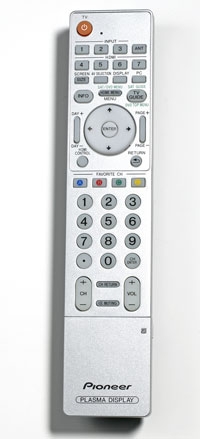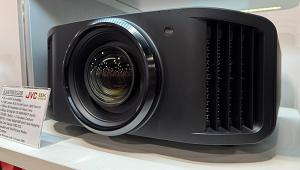Pioneer Kuro PDP-5010FD 50-inch Plasma HDTV Page 2
 The 5010FD is well endowed input-wise, with four HDMI and two component-video connections. You also get a VGA port for PCs and a CableCARD slot, while the set's USB input lets you plug in a flash drive or a digital camera and view slideshows via the HomeGallery feature.
The 5010FD is well endowed input-wise, with four HDMI and two component-video connections. You also get a VGA port for PCs and a CableCARD slot, while the set's USB input lets you plug in a flash drive or a digital camera and view slideshows via the HomeGallery feature.
Pioneer's remote control has a clean layout and a glow-in-the-dark keypad. A full set of direct input keys is located at the remote's top; you can't rename inputs with onscreen tags such as DVD or Cable, however. Located below the input keys are buttons to toggle through picture presets and display (aspect ratio) modes. The choices include a Dot-by-Dot setting that displays 1080i/p signals with no scaling or overscan, along with various stretch and zoom modes.
Setup As you'd expect from an upscale TV, there's no shortage of custom video settings. Basic settings can be adjusted for the Dynamic, Standard, Movie, and Game picture presets, and the Pioneer stores your changes. A User memory can also be fully and independently customized for each of the set's inputs. I was surprised to find no dedicated red, green, and blue adjustments for fine-tuning color temperature - that's something reserved for Pioneer's Elite models (one of which we'll be looking at soon). As it turned out, I didn't need them: After only basic adjustments in the User mode, the TV's grayscale was damn near perfect (see Test Bench).
I found some of the Pioneer's advanced picture adjustments useful. Turning on the Black Level setting actually helped improve the set's already very deep shadow rendition. And the three-step Gamma control's mid setting delivered the most linear-looking ramp of black-to-white grayscale steps. Selecting the 72-Hz Advanced PureCinema mode also resulted in very clear, solid-looking pictures when viewing movies on Blu-ray Disc with my player's 1080p/24 output active.
The TV's two noise-reduction modes also proved useful. Even at its highest setting, the 3D mode removed background noise without eliminating detail. And at its Low setting the Field mode was effective in cleaning up noisy cable TV programs without blurring details.
Performance The problem with even the best LCD TVs I've tested is that the picture flattens out in really dark movie scenes. This is where a plasma like the 5010FD earns its keep. As I watched The Lives of Others on Blu-ray Disc, shadows looked wonderfully deep yet detailed in a scene where the Stasi agent Wiesler, in an attic monitoring facility, listens to conversations between the writer Dreyman and his girlfriend. The rough walls, the knobs and switches on recording equipment, the texture of Wiesler's strange, circa-1980s East German jacket - all of these elements cut through the dimness to give the scene a satisfying sense of depth. And in a subsequent shot of the writer on his couch, the TV's sharp 1080p picture detail brought out both the grooves in his corduroy pants and the fine floral pattern of the upholstery.
- Log in or register to post comments











































